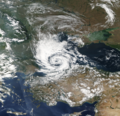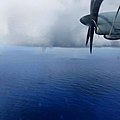User:RandomInfinity17
Hello! I track tropical and subtropical cyclones around the world.
| This user participates in WikiProject Tropical cyclones. |
| This user participates in the Non-tropical storms task force. |
| This user likes tracking tropical cyclones. |
| This user is really fascinated by the weather. |
| This user is interested in severe weather. |
| This user is a participant in WikiProject Weather |
| This user's most intense tropical cyclone ever experienced was Hurricane Marie in 2014. |
Interesting weather and space images
[edit]-
A possible subtropical cyclone in the Black Sea on September 27, 2005.
-
Radar scan of the 2021 Western Kentucky tornado lifting debris from the town of Mayfield 30,000 feet into the atmosphere.
-
Storm Dennis, the most intense European windstorm of the 21st century, on February 15, 2020.
-
Track of Tropical Storm Five of the 1952 Atlantic hurricane season, the northernmost forming Atlantic tropical cyclone.
-
A house that was wiped off its foundation after the extremely violent 2011 Hackleburg–Phil Campbell tornado.
-
Subtropical Cyclone Katie near Easter Island on May 2, 2015.
-
One of the first photos of the Andromeda Galaxy, taken in 1899 by Issac Roberts.
-
Satellite image of the 2022 Hunga Tonga–Hunga Haʻapai eruption and the extratropical remnants of Cyclone Cody.
-
Radar loop of the most prolific December tornado outbreak on record on December 15, 2021.
-
Cryovolcanoes spewing out ice at the south pole of Enceladus.
-
Hurricane Dorian approaching Canada as powerful extratropical cyclone on September 7, 2019.
-
A record-breaking bomb cyclone off the coast of the Pacific Northwest on October 24, 2021.
-
Subtropical Storm One at peak intensity on January 16, 2023.
-
C/2022 E3 (ZTF), a long-period comet, on January 27, 2023.
-
A waterspout inside of Tropical Storm Colin on June 6, 2016.
-
Track of Cyclone Freddy, the longest-lived tropical cyclone on record.
-
A potential subtropical storm of the coast of Morroco on February 17, 2002.
-
The 1904, Moscow tornado, one of the deadliest Russian tornadoes on record.
-
2023 CX1 entering Earth's atmosphere over France on February 13, 2023.
-
Subtropical Storm Raoni off the coast of Argentina on June 28, 2021
Tropical cyclones in 2023 (personal analysis)
[edit]
Subpages
[edit]My Subpages:
Good ones/Actively working on
[edit]- My sandbox
- Effects of the 1982–83 El Niño in Peru†
- Tropical Storm Namtheun (2021)†
- Unusual areas of tropical cyclogensis†
- Potential Tropical Cyclone Four†
- F6
- 2023 Naypyidaw tornado†
- List of costliest tropical cyclones
Inactive
[edit]- Significant tornadoes of 2023
- Table of Central Pacific tropical cyclones†
- Deadliest tropical cyclones by basin
Mainspace
[edit]- List of costliest tropical cyclones
- Template:Table of F5 and EF5 tornadoes
- Weather of 1985
- October 2022 Southern Ocean cyclone
† open to editing from others
My best works
[edit]- Weather of 2023 (
 / Top ) – Started article and contributed significantly to it by adding weather events as they go
/ Top ) – Started article and contributed significantly to it by adding weather events as they go - Template:10 deadliest tornadoes worldwide and Template:F5 and EF5 tornadoes (
 ) – Started them and my contributions are most of the template content
) – Started them and my contributions are most of the template content - List of costliest tropical cyclones (
 / Low ) – Started article and most of the article is my contribution, had to delete "some" but I still have the original still exists here
/ Low ) – Started article and most of the article is my contribution, had to delete "some" but I still have the original still exists here - Weather of 1985 (
 / Low ) – Started article and added all events
/ Low ) – Started article and added all events - October 2022 Southern Ocean cyclone (
 / Top ) – Created article for the most intense extratropical cyclone ever
/ Top ) – Created article for the most intense extratropical cyclone ever - In-flight fire (
 / Mid ) – Needed article for far too long
/ Mid ) – Needed article for far too long - 1966 Air New Zealand DC-8 crash (
 / Low ) – Technically, I didn't create this article, but I pushed it into B-class
/ Low ) – Technically, I didn't create this article, but I pushed it into B-class - Rocky Mountain Airways Flight 217 (
 ) – The "Mircale On Buffalo Pass" finally has its own article
) – The "Mircale On Buffalo Pass" finally has its own article - 2017 Teterboro Learjet crash (
 ) – Long article about a reckless accident that (thankfully) didn't kill any people on the ground
) – Long article about a reckless accident that (thankfully) didn't kill any people on the ground
Random Tropical Cyclone ()
[edit]Typhoon Goni, known in the Philippines as Super Typhoon Rolly, was an extremely powerful tropical cyclone that made landfall as a Category 5 equivalent super typhoon on Catanduanes in the Philippines, and in Vietnam as a tropical storm. It is the strongest landfalling tropical cyclone on record by 1-minute maximum sustained winds. The name "Goni" means swan in Korean. The nineteenth named storm, ninth typhoon, and second super typhoon of the 2020 Pacific typhoon season, Goni originated as a tropical depression south portion of Guam on October 26. It was then named as Tropical Storm Goni on October 27. On the next day, Goni explosively intensified over the Philippine Sea, becoming a Category 5–equivalent super typhoon on October 30. Goni maintained Category 5 strength for over a day, before making landfall on Catanduanes at peak intensity, with 10-minute sustained winds of 220 km/h (140 mph), and 1-minute sustained winds of 315 km/h (195 mph), with a minimum central pressure of 905 hPa (mbar; 26.72 inHg). It was the most intense tropical cyclone observed worldwide in 2020.
Following its first landfall, Goni rapidly weakened while it moved over the Sierra Madre mountain range of the Philippines. The storm brought severe flash flooding to Legazpi, as well as lahar flow from the nearby Mayon Volcano. There were widespread power outages as well as damaged power and transmission lines in Bicol. Crops were also heavily damaged. Over 390,000 out of 1 million evacuated individuals have been displaced in the region. Due to the extreme wind speed of the typhoon, two evacuation shelters had their roofing lost. Debris and lahars had also blocked various roads, as well as rendering the Basud Bridge impassible. In Vietnam, where Goni made landfall as a tropical depression, there was flooding in numerous areas, as well as eroded and damaged roads. This exacerbated the 2020 Central Vietnam floods, causing an estimated ₫543 billion (US$23.5 million). In all, the typhoon killed at least 32 people and caused at least ₱20 billion (US$359 million) worth of damage. The COVID-19 pandemic was also a concern for people in evacuation centers. (Full article...)























